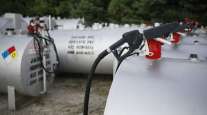Diesel Rises 4.9¢ to $3.116 a Gallon
This story appears in the Nov. 15 print edition of Transport Topics.
The U.S. retail diesel price average rose 4.9 cents to $3.116 last week, leaving trucking’s main fuel about a penny below its high point for the year, the Department of Energy said.
The increase came after a period of relative price stability and the same week that crude oil climbed to its highest level since October 2008.
Diesel’s increase followed no change in the average the prior week, DOE said after its Nov. 8 survey of fueling stations.
Meanwhile, the U.S. average price for regular gasoline rose 5.9 cents a gallon to $2.865 over the same week.
A year ago, the diesel average stood at $2.801 and gasoline was $2.666. The high point for diesel this year was $3.127 on May 10.
Crude oil futures topped $87 a barrel on Nov. 8 for the first time in more than two years and closed at $87.81 on Nov. 11 on the New York Mercantile Exchange.
DOE’s Energy Information Administration also said Americans are using more distillate fuel — perhaps because of an improving economy — leading to the diminishment of gluts in diesel, other distillates and gasoline.
Fleet managers’ reactions varied according to their general business conditions.
“Historically, it’s been the case that fuel always rises this time of year because of the drawdown for heating oil,” said Davis Transport President Jim McKinny. “But when you add to that the decline of the U.S. dollar, I think this year will be higher than in the past.”
McKinny said his Missoula, Mont., flatbed carrier has remained profitable and is doing better than in 2009, but the fourth quarter always has a flatbed lull that drags into January and February. Therefore, Davis runs fuel programs for its owner-operators to lock in discounts, and the company encourages them to reduce operating speeds.
“They have to pay for their own fuel, so a lot of them have become members of the ‘55-mph-club’ and they’re proud of it,” McKinny said, adding that his fuel surcharges are currently sticking well.
Refrigerated truckload carrier K&J Trucking, Sioux Falls, S.D., has less of an issue with fuel now, in part because business was so bad a year ago, said marketing manager Jim Gray.
“Some of our customers found an economic opportunity to abandon the reefer fuel surcharge during the recession. They took advantage of reduced rates in a short-term reaction that was not wise,” Gray said. Enough of his competitors have gone out of business, he said, that now K&J is running at full capacity.
“We can’t haul another pound of freight right now, and our loyalty is to those of our customers who kept us whole during the recession,” Gray said in explaining why his current surcharges for tractor and reefer fuel both stick very well.
Bloomberg News reported comments from oil analysts last week saying prices rose because the economy is improving, at least slowly, and therefore more petroleum is being used.
“The large jump in distillate demand, year-on-year, will bear watching,” John Kilduff, a partner at Again Capital, a New York-based hedge fund focusing on energy, told Bloomberg. “This could be an emerging trend that signals not only heating demand but also an uptick in economic activity.”
Consumption of distillate fuel surged 7% to 4.39 million barrels a day, the highest level since August 2008, the EIA report showed. Demand in the week ended Nov. 5 was up 24% from a year earlier, the wire service said.
The nation’s stock of ultra-low-sulfur distillate fell to 97.7 million barrels on Nov. 5, from 101.2 million the previous week, and it was 108.8 million barrels as recently as Oct. 1, EIA said.
Refinery activity also increased to 82.4% during the week ended Nov. 5 from 81.8% the previous week, EIA said.
“This is a wildly bullish report with draws across the board,” Jason Schenker, president of Prestige Economics, an Austin, Texas-based energy-research firm, told Bloomberg. “The crude number came as a surprise. The combination of a big increase in utilization and a drop in imports engendered a substantial decline in stocks.”
Crude inventories at Cushing, Okla., the delivery point for NYMEX futures, dropped 1.75 million barrels to 31.8 million, the biggest decline since the week ended Sept. 11, 2009. The decrease left stockpiles at the lowest level since the week ended April 2, Bloomberg said.
DOE also said last week that diesel would continue to rise into next year, averaging $3.19 at the pump in 2011.




